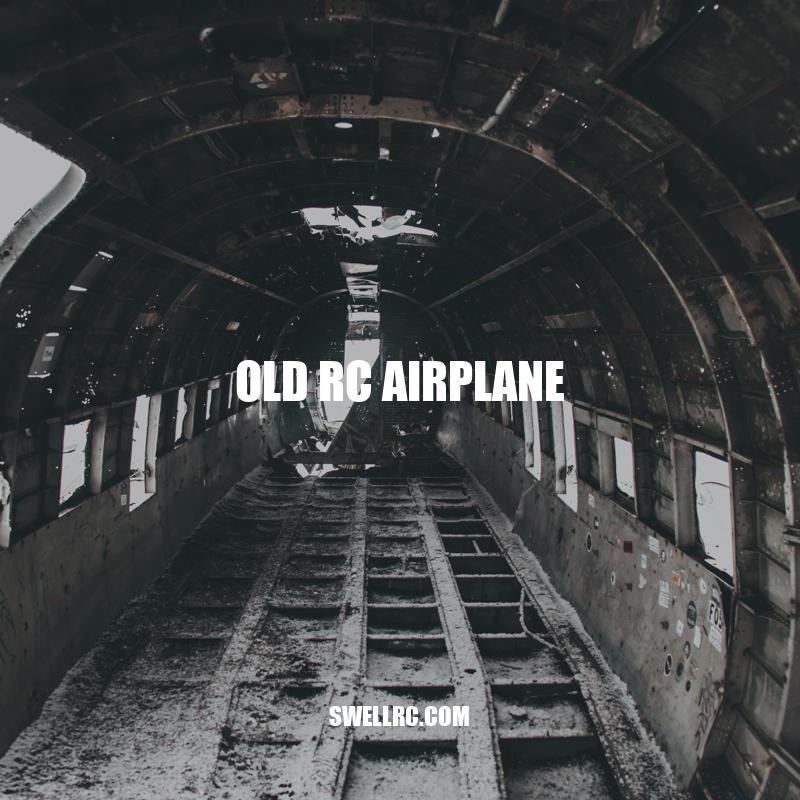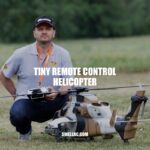Exploring the World of Old RC Airplanes
RC airplanes have been a popular hobby for many decades, and they continue to attract enthusiasts around the world. While modern drones and quadcopters have become increasingly popular in recent years, there’s something truly special about flying an old-school RC airplane. For many, piloting one of these vintage planes brings back memories of a simpler time, when things moved at a slightly slower pace and the world seemed just a little bit smaller. Of course, it’s not just about nostalgia; old RC airplanes offer a level of control and precision that’s difficult to find with other types of aircraft. Whether you’re looking to compete in high-stakes aerobatic competitions or simply want to experience the thrill of flight, an old RC airplane can be an excellent choice. But before you jump in, it’s important to understand some of the key considerations and challenges that come with piloting these unique planes. In this article, we’ll explore everything you need to know about old RC airplanes, from their history and types to maintenance, repairs, and flying tips.
History of Old RC Airplanes
RC airplanes date back to the early 1900s and have a long and rich history. Here are some of the key milestones:
- The first remotely controlled aircraft was developed in 1898 by Nikola Tesla, although it was never flown.
- In 1917, Archibald M. Low developed the first successful radio-controlled aircraft, which he used to attack German zeppelins during World War I.
- In the 1920s and 30s, hobbyists began building and flying their own remote-controlled planes, using systems that relied on wires and pulleys for control.
- By the 1960s, advances in transistor technology had led to the development of reliable, practical radio control systems that could be used for model airplanes.
- Throughout the 1970s and 80s, RC airplane technology continued to evolve, with more sophisticated control systems, improved materials, and more powerful engines.
- Today, old RC airplanes are prized for their historical value and unique sense of nostalgia, and they continue to be popular among enthusiasts around the world.
If you’re interested in learning more about the history of RC airplanes, there are many great resources available online. The Academy of Model Aeronautics has an excellent library of historical documents and photographs, and there are also numerous blogs and forums where RC enthusiasts share their knowledge and experiences. In addition to websites, there are also many books and magazines that cover the history of RC aviation, as well as practical tips and techniques for building and flying your own vintage planes.
What is the history of the RC plane?
The history of RC planes dates back to the early 20th century when hobbyists began experimenting with model aircraft. Here are some key milestones in the development of RC planes:
- In the 1930s, model aircraft enthusiasts started developing radio controls for their planes.
- During World War II, model planes were used as targets for anti-aircraft training.
- In the 1950s, commercial RC planes became available, and the hobby began to gain mainstream popularity.
- In the 1960s and 1970s, advances in technology led to faster, more responsive RC planes.
- Today, RC planes come in a variety of sizes and styles, from small electric-powered models to large gas-powered aircraft.
If you’re interested in learning more about RC planes, there are many online resources available, including hobby websites and online stores that sell RC planes and accessories.
Types of Old RC Airplanes
Old RC airplanes come in a variety of different shapes, sizes, and configurations, each designed for specific purposes. Here are just a few examples:
| Aircraft Type | Description |
|---|---|
| Gliders | Powered by gravity and wind, these aircraft have no engine and rely on thermal currents to stay aloft. |
| Sport Planes | Designed for speed and agility, these planes are built for precision aerobatics and other high-performance maneuvers. |
| Aerobatic Planes | Engineered to perform complex stunts and tricks, these planes are extremely maneuverable and can fly in tight formations. |
| Scale Models | Replicas of real-life aircraft, these planes are built to scale and are often used in competitions and displays. |
Some interesting facts about old RC airplanes include:
- Model airplane contests have been around since at least the 1930s, when the National Free Flight Society was founded in the US.
- Aerobatic competitions date back to the 1920s, when pilots began performing stunts and tricks at airshows and other events.
- Scale modeling has been a popular hobby for more than a century, with enthusiasts building and flying all kinds of planes, from simple gliders to complex jet fighters.
If you’re interested in learning more about the different types of old RC airplanes and how to build and fly them, there are many great resources available online. For example, the RC Groups forum has a dedicated vintage and old-timer forum where enthusiasts can share tips, techniques, and information about building and flying vintage planes. There are also many websites that offer plans and kits for building your own vintage airplanes, as well as forums and communities where you can connect with other enthusiasts and share your own experiences and knowledge.
What are RC planes used for?
RC planes, or radio-controlled planes, are used for various purposes such as:
- Recreational flying and entertainment
- Aerial photography and videography
- Competition and racing
- Education and learning about aerodynamics and aviation
There are also specialized RC planes that can be used for scientific research, military training, and even search and rescue operations.
If you are interested in purchasing an RC plane or learning more about them, websites such as horizonhobby.com and towerhobbies.com offer a variety of products and resources for enthusiasts.
Maintenance and Repairs
Maintaining and repairing an old RC airplane is a crucial part of ensuring that it remains in top condition and performs as expected. Some key tips and considerations for maintaining and repairing your vintage airplane include:
- Regularly check and maintain the engine to ensure it is running smoothly and efficiently.
- Inspect the fuel lines to make sure they are not cracked or damaged, and replace them if necessary to prevent leaks or fuel starvation.
- Check the control surfaces, such as the ailerons and elevator, to make sure they are properly aligned and move freely.
- Keep the fuselage and wing surfaces clean and free from debris and dirt that could cause damage or affect the plane’s aerodynamics.
- If your airplane requires repairs, be sure to use high-quality replacement parts and follow the manufacturer’s instructions carefully to ensure a safe and effective repair.
If you’re new to maintaining and repairing old RC airplanes, there are many online resources available to help you get started. For example, the RC Universe forum has a dedicated section for vintage and old-timer model airplanes, where you can ask questions and get advice from experienced pilots and builders. There are also many vintage airplane kits and replacement parts available from hobby shops and online retailers, making it easy to find what you need to keep your plane in top condition.
Can I do maintenance on my own plane?
In short, the answer is yes, you can perform maintenance on your own plane. However, it’s important to note that there are certain limitations and requirements that must be met.
- You must first obtain an FAA mechanic certificate in order to legally perform any maintenance on your aircraft.
- You must also comply with all applicable FAA regulations and guidelines for aircraft maintenance.
- If you’re not confident in your ability to perform maintenance tasks safely and correctly, it’s recommended that you seek the assistance of a licensed mechanic.
- Performing your own maintenance can save you money, but it’s important to balance that against the risks and potential costs of making mistakes or missing something important.
For more information and guidance on aircraft maintenance, consult resources such as the FAA’s Aircraft Maintenance & Repair webpage or relevant forums and websites for amateur pilots and aircraft owners, such as EAA.org.
Flying an old RC airplane is a unique experience that many aviation enthusiasts find rewarding and challenging. Some key tips and considerations for flying your vintage airplane include:
- Always check the weather conditions before flying to ensure that it is safe to do so.
- Find a suitable flying site that is large enough and free from obstacles or hazards.
- Before taking off, make sure that the airplane’s controls are working properly and that the battery or fuel levels are sufficient for your flight.
- Practice basic maneuvers, such as takeoff, landing, and turns, to get a feel for the airplane’s handling characteristics.
- As you gain experience, try more advanced maneuvers and stunts, but always make safety your top priority.
If you’re new to flying vintage RC airplanes, it’s important to approach the hobby with patience and a willingness to learn. There are many online resources available to help you improve your skills, including instructional videos, tutorials, and forums where you can connect with other hobbyists and pilots. You may also want to consider investing in a flight simulator or joining a local RC club to get hands-on instruction and guidance from experienced pilots. With practice and dedication, you’ll soon be able to master the art of flying old RC airplanes and experience the thrill of flight like never before.
How do you fly an RC plane for the first time?
Flying an RC plane for the first time may seem daunting, but with practice and the right guidance, it can be an enjoyable experience. Here are essential tips on how to fly an RC plane for the first time:
- Start with a beginner-friendly model and avoid complicated setups
- Choose an open and flat field with no obstacles and minimal to no wind
- Understand your plane’s controls, orientation, and available flight modes
- Hand-launch the plane gently while keeping the throttle low and straight
- Use small and smooth inputs and make sure to anticipate your plane’s movements
- Practice different maneuvers and landings to improve your skills
There are many resources available online that can provide more in-depth information on this topic like RC Groups, Flite Test, and RC Unboxing YouTube channel. Additionally, some companies like HobbyZone and Horizon Hobby offer beginner-friendly RC planes, which are designed to make the learning process easier.
Conclusion
In conclusion, old RC airplanes provide a unique glimpse into the history of aviation and continue to captivate enthusiasts around the world. From their humble beginnings in the early 1900s to the advanced radio control systems of today, these planes have a rich and fascinating history that is well worth exploring. Whether you’re a seasoned pilot or a newcomer to the world of aviation, flying an old RC airplane is an experience that should not be missed. By following basic maintenance and safety guidelines, practicing your flying skills, and connecting with other hobbyists and enthusiasts, you can unlock the full potential of these incredible machines and take your passion for aviation to new heights. So why not give it a try and see for yourself what makes old RC airplanes such a special and enduring part of aviation history?



